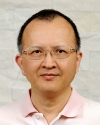楊大衍 博士 研究成果
Advanced Intelligent Systems, 3(7):2000273 (2021).
Quantum computers adopt an n-state quantum mechanical system to manipulate the superposition state. However, molecular transistors have not been used to build up the quantum logic gate. Here, we demonstrate that DNA, RNA and protein are promising media for quantum computers, and one could employ residue pairs, including nucleotide base pairs and amino acid pairs, via proton-coupled electron transfer to fabricate a quantum logic gate. In the residue pair, the proton transfer between donor and acceptor states fulfill a qubit. Both the DNA-CG (3-qubit) nucleobase pair and nucleotide base pair obey the Toffoli gate. AT (2-qubit) nucleotide base pair behaves as a SWAP gate and a CNOT gate. Furthermore, the AU and RNA-CG nucleotide base pairs follow the CNOT gate and Toffoli gate, respectively. In addition, a pair of amino acids achieves 1-qubit and satisfies the Pauli-X, -Y and -Z gates. The generators of universal quantum logic gates are obtained. We demonstrate that quantum computers are constructed by molecular transistors in the size of one nanometer, and DNA, RNA and protein residue pairs are used to make universal quantum logic gates. The double helix of the nucleic acid is a quantum computer. These results provide a new perspective in topological quantum computers.
Scientific Reports 7, 39792 (2017).
Proteins are of interest in nano-bio electronic devices due to their versatile structures, exquisite functionality and specificity. However, quantum transport measurements produce conflicting results due to technical limitations whereby it is difficult to precisely determine molecular orientation, the nature of the moieties, the presence of the surroundings and the temperature; in such circumstances a better understanding of the protein electron transfer (ET) pathway and the mechanism remains a considerable challenge. Here, we report an approach to mechanically drive polypeptide flip-flop motion to achieve a logic gate with ON and OFF states during protein ET. We have calculated the transmission spectra of the peptide-based molecular junctions and observed the hallmarks of electrical current and conductance. The results indicate that peptide ET follows an NC asymmetric process and depends on the amino acid chirality and α-helical handedness. Electron transmission decreases as the number of water molecules increases, and the ET efficiency and its pathway depend on the type of waterbridged H-bonds. Our results provide a rational mechanism for peptide ET and new perspectives on polypeptides as potential candidates in logic nano devices.
目前位置:本所人員 / 研究人員 / 楊大衍 / 全部研究成果
中央研究院 原子與分子科學研究所版權所有 |
個人隱私權聲明 |
保有個資檔案公開項目彙整表 |
行動版
地址: 106319 台北市羅斯福路四段一號 或 106923 臺北臺大郵局 第23-166號信箱
電話:886-2-2362-0212 傳真:886-2-2362-0200 電子郵件:iamspublic@gate.sinica.edu.tw
最後更新於 2025-04-30 14:15:19
地址: 106319 台北市羅斯福路四段一號 或 106923 臺北臺大郵局 第23-166號信箱
電話:886-2-2362-0212 傳真:886-2-2362-0200 電子郵件:iamspublic@gate.sinica.edu.tw
最後更新於 2025-04-30 14:15:19
 中央研究院 原子與分子科學研究所
中央研究院 原子與分子科學研究所

